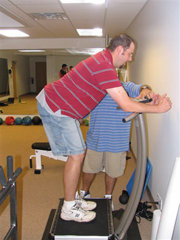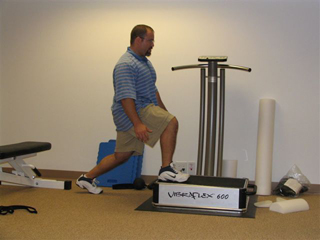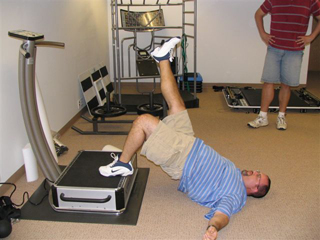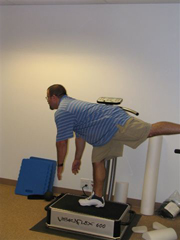So as many of us know, I am the Director of Clinical Education for the Vibraflex Whole-Body Vibration WBV) Platform. I believe very strongly in the benefits and uses of WBV, and I think it has a very global role in what many of us are doing. At this point, I don’t see it as a fad or something that will come and go simply because it is not something that can be duplicated through some alternate method. We’ll talk about the mechanics of what a WBV platform does, how the body responds to it, the many evidence-based uses for WBV, and some very fundamental differences between some of the commercial units that are available.
It was an odd path that brought me to become interested in WBV in the first place. It was in my second year of physical therapy school when I was offered my first athletic training job in professional basketball. The team was the New Jersey Shorecats in Asbury Park, NJ coached by Rick Barry. Now I wasn’t around for the Rick Barry that some of the old timers remember, but in case anyone is wondering, Rick is not a bad guy in any way. I’ve heard the stories, but like with many celebrity types, what is portrayed probably is closer to the opposite than the truth. Well, between 1998 and 2006 I was lucky enough to have worked in professional basketball every year including 2 stints in the NBA with the Nets and 76ers. And primarily as a Certified Athletic Trainer, I had the privilege to become quite familiar with patella tendonitis, the obligatory anterior knee pain suffered by most athletes in a jumping sport.
As a young enthusiastic clinician, I did all the ultrasound, cross-friction massage, straight leg raises like I was taught, and most guys got better. Of course they were also resting, and as young super humans, it was over my head to understand that the rest was what was getting them better, not the bogus rehab. When I arrived to the Sixers in 2003, it was around the same time that I got into the Functional Movement Screen and using the principles with the team. Aside from the brilliance of understanding integrated movement and regional interdependence from the FMS along with sound training methods, there was one thing about the FMS that really grabbed me. Regardless of the FMS score, we saw when the bar got heavy or the movement got fast, the pattern would denigrate to an injurious pattern. It was all in their head as a learned movement. All the pattern retraining wasn’t nearly enough to combat the literally billions of jump shots an NBA player had taken from the time they were 5 or 6 years old. The poor squat pattern that is a perfect jump shot always counteracted what we were doing with our training. We needed another tool to break up the movement pattern at the learned level. How could we keep the brain out of screwing up the movement?
Enter Whole-Body Vibration. One of the training centers that some of the guys went to during the summer had a WBV platform, so I would hop on and let it shake. It was terribly uncomfortable, and my players didn’t really use it for the same reason. But if it was available to them, I had to learn about it, which I did. One thing I learned was that one of the major principles of WBV is the activation of the stretch-reflex, which of course is a spinal reflex. The stretch reflex suggests that when placed upon a sufficient degree of stretch, a muscle will contract to counter the lengthening.
So muscles were contracting as a result of a spinal reflex when the machine turned on. The signal to contract started at the floor, traveled to the spinal cord and then back to the effector muscle. The brain was out of the equation. The stronghold the brain had on the muscles of the movement was lifted. I figured as long as I could get them into the position I wanted, I could activate the stretch-reflex and train the muscles we wanted for a good hip-dominant squat and lunge pattern. And we could keep the central neurological control away from the pattern.
So we got a platform in the summer of ’05, and in ’05-’06, we had zero games missed from patella tendonitis. I’m not going to sit here and say any one thing that we did was the reason for anything good or bad, but this was what got me into WBV. It’s become a tremendous interest of mine particularly after the positive results in how we were using it. And it was a little good for the ego too when Allen Iverson said we should have had that #@&#^ thing for the last 9 years.
So what happens when the machine turns on? Most WBV platforms are mechanical. I know of one machine that somehow uses sound to create the floor to vibrate. Either way, vibratory or oscillatory movements in the floor cycle 5 to 60 times per second depending on the make and model. So the floor vibrates, and you ask if this is like the old 1970’s belt that wrapped around your waste to shake the fat off you. Well, this is quite different.
Let’s go back to the 1950s where Russia was tremendously committed to space travel. Of course in space, there is zero gravity, and as we know deloading of the body will reliably yield bone density loss. Russian cosmonauts used some of the first WBV platforms prior to going into space, and upon returning, they had less bone density loss than their colleagues who had not trained with vibration. How did this happen?
It happened because when the WBV platform turns out, that floor is unlike Earth in regards to gravity. It is now a hypergravity environment. The combination of the amplitude and frequency in which the platform is moving (calculated by a multitude of serious equations) creates a “fake Earth” that yields G Forces much larger than what is on Earth. Gravity is a measure of acceleration, and on Earth, it is always 9.8 m/s2. We weigh what we weigh on Earth because 9.8 m/s2 says we do. That degree of pull against us requires a complementary degree of force production for us to stay upright. If the WBV platform allows for let’s say 3 G’s, the acceleration is now close to 30 m/s2, it would theoretically take 3 times as much force to maintain the position. It doesn’t quite work out that way, but the reasons that the Cosmonauts that trained with WBV had less bone density loss was because they were trained in a hypergravity environment before they went up into space. They had increased their bone density from training in a hypergravity environment, so when they lost density at zero G’s in space, it was not as large an impact.
The equation of F=MxA governs all of the strength training that we do. The way to increase force is to load up the mass. More plates on the bar means more Mass, which is really just an extension of our bodyweight, but we said before that Acceleration always stays the same on Earth. Now we have a tool that can increase Force without increasing Mass. Increased G’s on the platform means that we may weigh more than what we weigh at 1 G, and require more force to maintain the upright position. The 45# bar we hold on the platform isn’t really 45# anymore. It feels that way because, go back to my original “gravitation” to WBV, the brain is out of the equation.
So basically from afar, when a WBV platform begins to vibrate, we are seeing a hypergravity environment created, which allows us the only way possible to manipulate the A in F=MxA.
What happens when we get on the platform? The body responds to vibration based on the phenomenon of the Tonic Vibratory Reflex (TVR). The TVR says the following. When a muscle is subjected to certain safe frequencies (below 30 Hz) of vibration stimulus, the muscle on stretch will respond through the stretch-reflex and offer a contraction. It also says that when a muscle on slack is met with vibration, it responds with the Golgi Tendon Response through further relaxation. So we can see that depending on the position a muscle is in, we can get a strengthening effect or a flexibility effect. It is somewhat counter-intuitive when you think about it, but the TVR shows a stretched muscle will get stronger, and a slacked muscle will get relaxed.
There is a wealth of research that is growing regularly to support the basic effects of strength and flexibility, along with improving bone density profiles that we mentioned before. I would never suggest vibration training as better than any other strengthening tool, but research shows to be at worst, equal. And now for those of us that have an inhibited individual, be them deconditioned or in pain or for some reason resistant to using loaded patterns to strength train, we have an amazing tool to gain strengthening effects without ever touching a weight.
By many accounts strength is secondary to power, and we know our definitions. So let’s put some things together. As the stretch reflex hits, we are getting a muscle contraction. Those ontractions are occurring in a hypergravity environment, so there is a measure to increase the force of these contractions. And as that hypergravity environment is created through a frequency, it is that same frequency that says how many times a second that muscle is contracting. Submaximal loads performed at incredibly high rates of speed. That sounds like power training to me. As a platform vibrates at 26 Hz, we are getting 26 contractions a second. We have now another amazing tool to support training for power.
Our list of uses so far including evidence-based practice for others…
- Strength
- Flexibility
- Power
- Bone Density Profile
- Female Hormonal Profile
- Post-Training Recovery
- Cardiovascular Measures
- Muscle Excitability (Movement Pattern Retraining)
- Increased Blood Flow
- Increases in HgH and Testosterone
- Decreases in Cortisol
- Fall Prevention
- Decreased Pain through Descending Inhibitory Control
- Improved control of Continence
- Gait Training
- Muscle Activation in Neurologically-challenged (stroke, spinal cord, Parkinson’s) Patients
No, it’s not all good. There is an acclimatization to the hypergravity environment that all individuals go through. Without the acclimatization phase, we can have some similar effects that we get from roller coasters that go up to 6-8 G’s. You may see what you had for lunch after you ate it.
As brilliant as the training effects can occur through short training sessions, overtraining effects can be equally as quick. When we are training in a foreign environment based on increased gravity, an evidence-based approach is all the more important. Playing around on a WBV platform or not following sound independent research can mess up an entire training program. Remember that WBV is loading simply through increasing the Acceleration in F=MxA. You wouldn’t load up the bar (mass) for someone that couldn’t move his or her bodyweight. Loading up the bar through acceleration is equally as poor a choice.
Contraindications include but are not limited to:
- Active Inflammatory Processes
- Acute Thrombosis
- Bone Tumors
- Unhealed Fracture
- Recent Implant or Arthroplasty
- Gall, Kidney, or Bladder stones
- Known Metastases
- Pregnancy
ot all WBV platforms are created equally. If one research article reports a frequency of 25 Hz on a platform that moves a certain way, I think it is fair to say that another platform that starts at 30 Hz and moves in a totally different way would not apply to the efficacy of the 2nd machine. Keep in mind that frequency and the platform very much matter. I think what is unfortunate is that some of the major players in the WBV market, such as Powerplate and iTonic, are using much research from other platforms to support their own product. This past weekend during a break at the SFMA course, I had a buddy of mine randomly click on 4 research links on Powerplate’s healthcare Website. Result 1: not even a research article or abstract; there was no mention of any variables of the WBV machine or journal. Result 2: used Powerplate in the research, admitted thanks at the end of the article that they had received the machine for free from Powerplate, probably not the most reliable research when it is funded by the company. Result 3: research used Gallileo, which is what the Vibraflex is called in Europe. Result 4: research again used Gallileo. Remember, my buddy picked them randomly, and he had no prior knowledge to anything vibration-related. Check yourself and see what happens. We very much need to understand that the research on WBV is extremely dependent on frequency, amplitude, type of platform used, and position on the platform. To use research from one platform to support another is not only fairly unethical in my opinion, but also not applicable. It’s not like the Chatanooga ultrasound machine that has all the same inner workings as the Dynatron.
The frequencies of WBV that the independent research has shown positive outcomes have been in the 20s, primarily the high 20s. The EMG research clearly shows that after 30 Hz, there is an enormous drop off in the strength of the contraction elicited by the stretch-reflex. A recent study in Journal of Strength and Conditioning using Powerplate and frequencies over 30 Hz showed a dampening of the H-Reflex, which is the tenet of muscle excitability. What basically this means is that for a time after using higher frequencies of vibration, it actually became more difficult to initiate a muscle contraction. Frequency matters, and the independent research dies off after 30 Hz.
I am not aware of any comparative study that has shown a frequency >30 Hz program outperforming a frequency of <30Hz program. It is very sensational to suggest that with the higher frequencies, you get more contractions per second. And this is very true. You do get more contractions with the higher frequencies, but their strength is paltry, and there is poor support in the literature for these programs.
So why would a platform use the higher frequencies if under 30 Hz is where the research is? The answer lies in the type of platform. There are 2 types of WBV platforms in regards to the direction of how the vibration is imparted: Vertical Vibration, such as Powerplate, Wave, iTonic, Pneumex, etc., and Rotational Vibration, which is only the Vibraflex. Powerplate actually moves in 3 planes, but 70% of it is vertical, and it is recognized as vertical in the literature. The 3 planes of vibration all vector into the vertical, so it is a fairly sensational statement to suggest since we move in 3 planes, a platform that moves in 3 planes is better. On a vertical platform, the floor will basically vibrate up and down. So in the down position in vertical vibration, you are literally off the ground in a jumping pattern. It happens so fast that you don’t reach the floor before it comes back up to meet you.
On a rotational platform, of which there is only one as the technology is patented, the platform vibrates side to side like a teeter totter. The pattern is similar to a reciprocal gait or bounding pattern. Now we said before that the research shows success with less than 30 Hz, and this is true of both vertical and rotational platforms. I surmise that the reason some platforms do not subscribe to the research is because 1) the sensationalism of more is better, which is not evidence-based, and 2) vertical vibration at the appropriate frequencies is terribly uncomfortable.
Why do people complain of teeth chattering and eyes popping out on a vertical platform? Stand shoulder width apart and look down in between your legs. There is a whole lot of nothing, right? Well imagine a line of force, in our case vibration, coming straight up into your private area from the floor. There is not a whole lot of muscle to absorb the vibration through the TVR principles. So the vibration continues on through the pelvis and spine. Remember bone is an elite conductor of vibration. Again very little muscle is in the immediate line of the vibration, and it continues to travel into the cranium where there is nowhere else to go. Dr. Rubin at SUNY-Stony Brook measured 3 G’s in the head of individuals participating with Powerplate. Increasing head acceleration should sound a lot like what our football players are dealing with though the violent head traumas and collisions. People complain of eye pain, headaches and concussive symptoms after vertical vibration for this very reason. Powerplate would suggest using a deep squat pattern to get the vibration out of the head, but what if the person can’t squat deep? Poor squat patterns on the toes and using pads to dampen the vibration limit the usefulness of these platforms. Efficacy is debatable in the literature, and the negative effects of vertical vibration are documented. I recommend reading the literature for yourself and not relying on the flash of control panels or amazing endorsements.
So is rotational vibration safer? Rubin measured only 0.2-0.3 G’s in the head on a Vibraflex. Visualize that same shoulder width stance. Now imagine 2 lines of vibration coming from just outside of your feet traveling towards your hips. As this occurs through the teeter totter motion, the vibration vectors through glut medius and quadratus lumborum, the very muscles that we are in tune with as we attempt to improve single-leg stance measures. There are not nearly the ill sensations through the head with rotational vibration. This is supported through Rubin’s scientific support as well as empirical evidence through individuals that have had the opportunity to compare vertical and rotational platforms.
Does vertical vibration work? The research is very inconclusive. Is there some very dominant research questioning that its safety should be studied further? Yes.
Is rotational vibration better? I believe so, but I am not the end all, be all when it comes to ibration. I will change my tune in a millisecond if I was shown compelling evidence. And not from articles or high-profile users where the platform was given to the them for free.
Whole-body vibration is a powerful and well-researched tool. Please continue your own research in checking for yourself the statements of this article and learning if it has a role in your practice.
Charlie Weingroff PT, ATC, CSCS
Latest posts by Charlie Weingroff PT, ATC, CSCS (see all)
- Whole Body Vibration Basics for Physical Therapists - May 1, 2009





Comments
Thanks for sharing such valuable information.